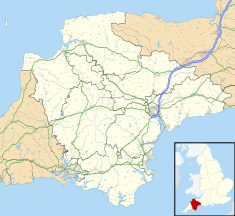| Devon County Hall | |
|---|---|
 | |
| Location | Exeter, Devon, England |
| Coordinates | 50°42′53″N 3°31′03″W / 50.7146°N 3.5175°W / 50.7146; -3.5175 |
| Built | 1964 |
| Architect | Donald McMorran |
| Architectural style(s) | Neo-classical style |
| Listed Building – Grade II* | |
| Designated | 24 April 1998 |
| Reference no. | 1323701 |
 | |
Devon County Hall is a municipal building in Topsham Road, Exeter, Devon, England. The building, which is the headquarters of Devon County Council, is a Grade II* listed building.
History

Following the implementation of the Local Government Act 1888, which established county councils in every county, it became necessary to find a meeting place for Devon County Council. The administration of justice had been conducted from Rougemont Castle and county leaders decided that the administration of the county should also be conducted from new offices established within the castle in 1895 and that meetings of the county council should be held in a courtroom there. This arrangement continued until the mid 20th century when county leaders decided that they needed dedicated facilities: a site was selected in the grounds of Bellair House, a mansion rebuilt around 1700 by the merchant John Vowler, and an adjoining early Victorian house, known as Coaver.
The foundation stone for the new building was laid on 16 October 1958. It was designed by Donald McMorran in the neo-classical style and was officially opened on 14 July 1964. The design involved a three-storey main frontage facing a large expanse of parkland with Bellair House forming the left hand wing and a new block forming the right hand wing; the central section of the main frontage featured three segmental archways leading to an inner courtyard. Internally, the principal room was the council chamber, which was located on the north east side of the inner courtyard; a substantial clock tower was erected above it. The Victorian house, Coaver, was also converted into the complex, as a social club for council staff.
An annexe to the east of the main building, to meet the ever increasing accommodation needs of the county council, was completed in 1984. A sculpture of a female figure by Barbara Pearson entitled "Loving Care" was erected outside Bellair House to commemorate the centenary of Devon County Council in 1988.
Queen Elizabeth II, accompanied by the Duke of Edinburgh, attended a reception in the building, as part of a tour of the county to celebrate her Golden Jubilee, on 1 May 2002.
Works of art inside the building include watercolour paintings by Hugh Gurney depicting Odam Bridge and the River Mole near Meethe in Devon.
References
- ^ Historic England. "Devon County Hall (1323701)". National Heritage List for England. Retrieved 7 September 2019.
- "Local Government Act 1888". Legislation.gov.uk. Retrieved 17 August 2019.
- Mellor, Hugh (1989). Exeter Architecture. Chichester: Phillimore. p. 77. ISBN 0-85033-693-7.
- "Kelly's directory of Devon, 1902". Retrieved 7 September 2019.
- "A brief history of Devon County Council". Devon County Council. Archived from the original on 3 February 2011. Retrieved 30 October 2009.
- Historic England. "Bellair (1224137)". National Heritage List for England. Retrieved 12 October 2020.
- ^ Cherry, Bridget; Pevsner, Nikolaus (2002). The Buildings of England: Devon. Yale University Press. p. 401. ISBN 978-0-300-09596-8.
- "20th Century Society South West Region visit to Devon County Council, County Hall, Exeter". 20th Century Society. 22 April 2017. Retrieved 14 November 2020.
- ^ "History of County Hall". Devon County Council. Archived from the original on 20 March 2012. Retrieved 31 October 2009.
- "Devon County Council. Devon County Hall, Exeter: official opening, 14 July 1964". Devon Bibliography. 3 September 2019. Retrieved 12 October 2020.
- "Bellair, Devon County Hall, Topsham Road, Exeter". Alamy. Retrieved 12 October 2020.
- "The Queen's Golden Jubilee programme". Buckingham Palace. 29 January 2002. Retrieved 12 October 2020.
- Guerney, Hugh. "Landscape at Odam Bridge, Devon". Art UK. Retrieved 12 October 2020.
- Guerney, Hugh. "The River Mole near Meethe, Devon". Art UK. Retrieved 12 October 2020.